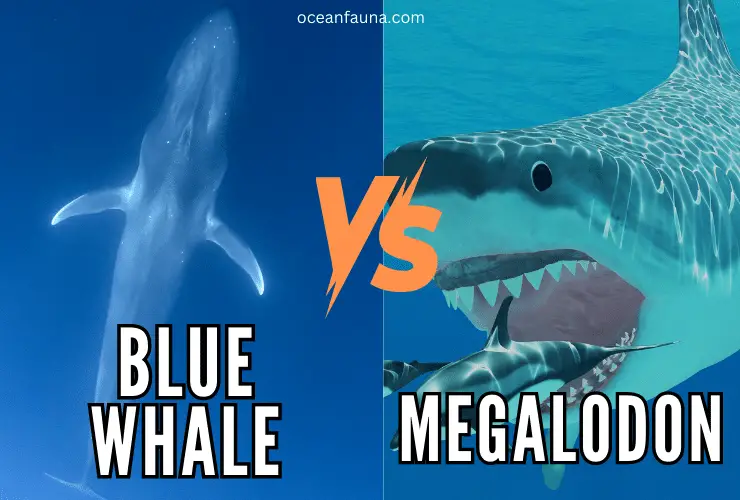Blue whales and megalodons, two colossal marine inhabitants, are worlds apart in their anatomy, diet, and evolutionary histories.
The blue whale, a mammal, breathes air and nourishes its calf with milk. In contrast, the megalodon, a prehistoric shark, was a cold-blooded creature with gills to extract oxygen from water. Blue whales use baleen plates to filter-feed on vast swarms of tiny crustaceans. Conversely, megalodons were terrifying apex predators, using their enormous teeth to tear into larger marine prey.
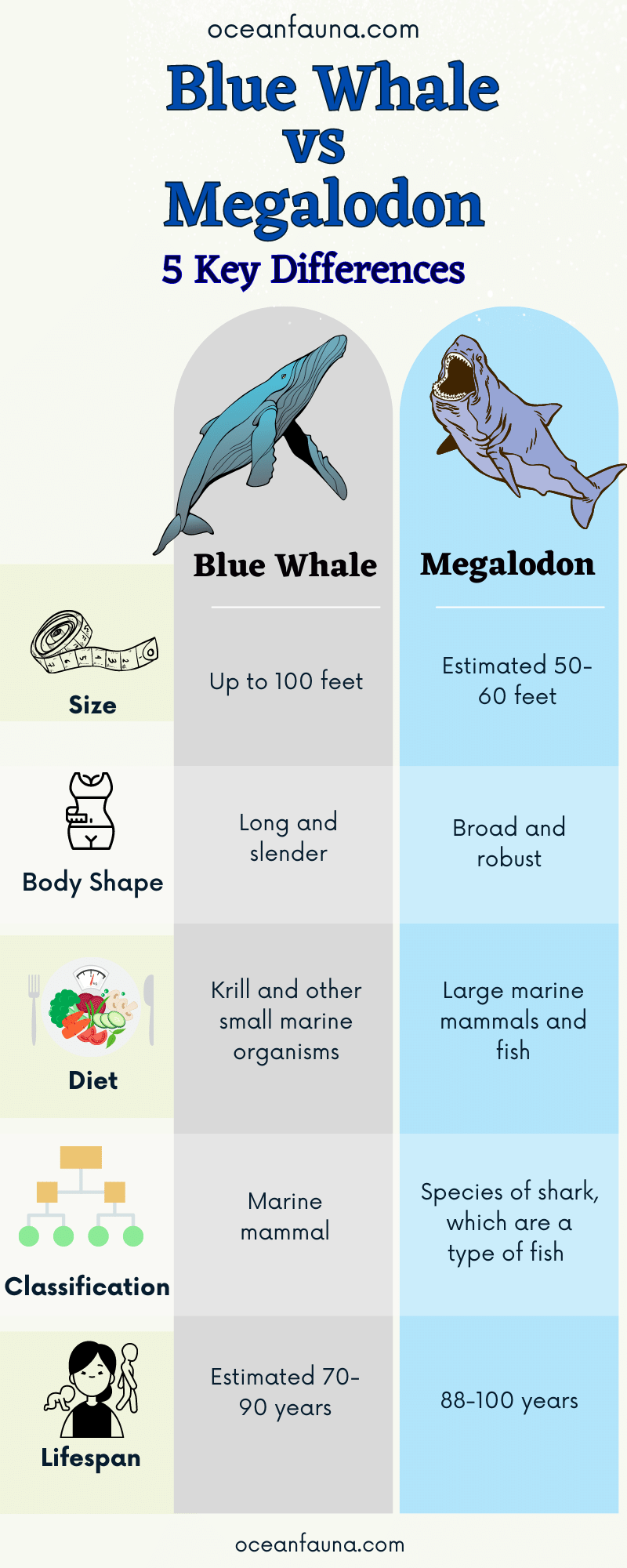
While blue whales grace our oceans today, though, in threatened numbers, megalodons vanished from the seas roughly 3.6 million years ago. Their fossils are all that remain of their once-mighty reign.
Keep reading to explore the incredible contrasts between the blue whale and the megalodon! There’s a world of information waiting to be discovered!
Blue Whale vs Megalodon – A Quick Comparison
| Feature | Blue whale | Megalodon |
| Scientific Name | Balaenoptera musculus | Carcharocles megalodon |
| Family | Balaenopteridae | Otodontidae |
| Body Shape | Long and slender | Broad and robust |
| Size | Up to 100 feet | Estimated 50-60 feet |
| Diet | Krill and other small marine organisms | Large marine mammals and fish |
| Habitat | All oceans except the Arctic and enclosed seas | Worldwide in warm oceans |
| Social Behavior | Mostly solitary, but can form loose aggregations in feeding grounds | Presumably solitary, based on modern large shark behavior |
| Lifespan | Estimated 70-90 years | 88-100 years |
| Gestation Period | About 11-12 months | Presumably, about 12 months |
| IUCN Status | Endangered | Extinct |
Blue Whale vs Megalodon – What Are the Key Differences?
Despite being from vastly different periods of Earth’s history, blue whales and megalodons share some intriguing commonalities. Both are titans of the sea, dominating their respective environments in size and power. They are apex creatures in their ecosystems, significantly influencing the oceanic environment around them.
However, despite these similarities, blue whales and megalodon are incredibly different in most other aspects. Their diets, behavior, reproductive habits, and much more diverge substantially. This shows how amazing and varied sea life can be. So, let’s dive deeper and explore these differences in detail.
1. Taxonomy and Scientific Classification
One of the most significant differences between the blue whale and megalodon lies in their taxonomy and classification.
Blue whale
The blue whale is a marine mammal. It belongs to the class Mammalia and is scientifically called Balaenoptera musculus.
This giant whale falls under the infraorder Cetacea, which encompasses all whale, dolphin, and porpoise species. It’s part of the Balaenopteridae family, also called the Rorqual family.
The blue whale has five recognized subspecies spread across the globe:
- Northern blue whale (B. m. musculus)
- Antarctic blue whale (B. m. intermedia)
- Northern Indian Ocean blue whale (B. m. indica)
- Pygmy blue whale (B. m. brevicauda)
- Chilean blue whale ~ Source
Megalodon
The megalodon is an extinct species of shark, classified within the class Chondrichthyes. Scientifically, it’s known as Carcharocles megalodon.
The Megalodon was part of the order Lamniformes, as detailed in an article published in the journal Revista Brasileira de Paleontologia. It belonged to the family Otodontidae, characterized by massive teeth – a trait the megalodon clearly exhibited.
| Classification Level | Blue Whale | Megalodon |
| Kingdom | Animalia | Animalia |
| Phylum | Chordata | Chordata |
| Class | Mammalia | Chondrichthyes |
| Order | Artiodactyla | Lamniformes |
| Family | Balaenopteridae | Otodontidae |
| Genus | Balaenoptera | Carcharocles |
| Species | B. musculus | C. megalodon |
Also Read: Blue Whale vs Humpback Whale: Key Differences Explained
2. Habitat and Distribution
Blue Whales and Megalodons have distinct preferences and ranges regarding their habitats.
Blue whale
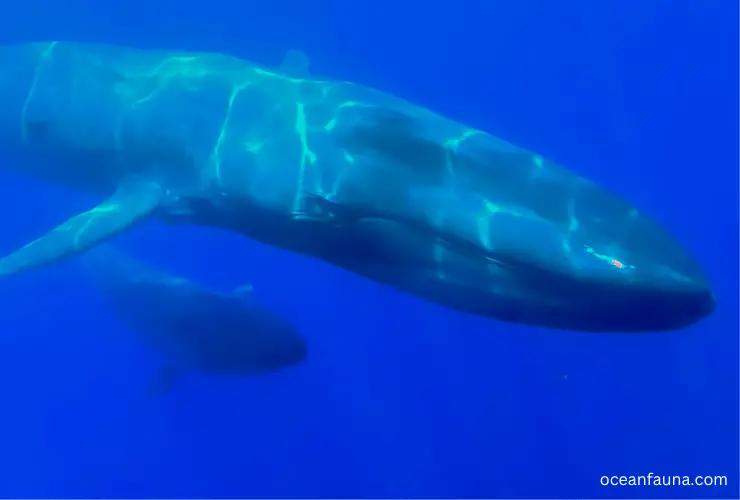
The blue whale is found in all the world’s oceans but the Arctic. These marine mammals generally prefer deeper waters but will come closer to shore while feeding or during the breeding season.
Also Read: Blue Whale Vs Orca: Key Differences & Battle Winner
Blue whales migrate annually, traveling vast distances between their feeding grounds in cooler, high-latitude waters and their breeding and calving grounds in warmer, low-latitude waters.
There are slight variations in the distribution of different blue whale subspecies, as detailed by the National Oceanic and Atmospheric Administration.
- Northern blue whales: North Pacific and Atlantic.
- Antarctic blue whales: Southern Ocean.
- Northern Indian Ocean blue whales: Somalia, South Arabia, the Southwest coast of India, Sri Lanka, and the Maldives.
- Pygmy blue whales: the Indian and Southern Pacific Ocean.
- Chilean blue whales: Eastern South Pacific.
Megalodon
Megalodon once swam the world’s oceans approximately 3.6 million years ago. Given the extensive fossil record of its teeth, it’s believed that the megalodon had a cosmopolitan distribution, meaning it inhabited waters worldwide.
The megalodon favored warmer waters, both coastal and offshore. This preference is inferred from the locations of fossil teeth, which have been found in significant numbers along the coasts of
- North and South America
- Europe
- Africa
- Japan
- Australia.
Megalodon is believed to have been unable to survive in colder temperatures due to its ectothermic, or cold-blooded, nature. ~Source
| Habitat & Range | Blue Whale | Megalodon |
| Geographic Range | All oceans except the Arctic | Global (preferred warmer waters) |
| Location Preferences | Deepwater, closer to shore for feeding and breeding | Both coastal and offshore in warmer waters |
| Migration Pattern | Migrates annually between feeding and breeding grounds | Unknown |
3. Physical Appearance
The physical appearances of the blue whale and the megalodon are quite distinct due to their different evolutionary paths and adaptations to their respective environments.
Blue whale
- The blue whale is the largest creature ever known to have lived on Earth. Adult blue whales can be up to 100 feet long, weighing almost 200 tons. Females are typically bigger than males, a characteristic common in baleen whales.
- Their bodies are long and slender, colored a mottled bluish-grey, and their underbellies have a slightly lighter color.
- The blue whale’s head is broad and flat, making up about one-fourth of the body length.
- Its mouth is equipped with baleen plates instead of teeth.
- The blue whale has a single blowhole with a remarkably high and straight spout, reaching up to 9 meters when it exhales.
- They have a small dorsal fin towards the end of their back.
Megalodon

- The Megalodon was an enormous predatory shark. Estimates based on tooth size and analogy with modern relatives suggest that megalodon may have reached lengths up to 60 feet.
- Megalodon likely had a robust, fusiform body and a conical snout. Its jaws were massive and lined with large, thick teeth designed for breaking bone.
- Megalodon teeth are among the most common fossils found and are highly prized by collectors. These teeth could reach lengths of over 7 inches. ~Kentucky Geological Survey
- As with all sharks, the megalodon had a skeleton made of cartilage, not bone, which is why their fossils are primarily teeth and a few vertebral centra.
| Appearance | Blue Whale | Megalodon |
| Length | Up to 100 feet | Estimated up to 60 feet |
| Weight | Up to 200 tons | Unknown, likely several tons |
| Body Shape | Long and slender | Robust and fusiform |
| Mouth | Baleen plates for filter-feeding | Large, thick teeth for predation |
| Skeleton | Bone | Cartilage |
4. Diet and Feeding Habits
The diets and feeding habits of the blue whale and the megalodon are also significantly different.
Blue whale
Blue whales are filter feeders, meaning they feed by straining tiny prey from the ocean water. They have a series of 270 to 395 baleen plates (comb-like structures in their jaws) that trap small animals from seawater.
Their main food source is krill, tiny shrimp-like creatures. A single adult blue whale eats approximately 4 tons of krill daily during feeding seasons. ~American Cetacean Society
They are known for their ‘lunge feeding’ technique, where they accelerate into a swarm of krill with their mouth open, taking in a large amount of water and krill, then forcing the water out through their baleen plates, trapping the krill inside to be swallowed.
Watch this video:
Megalodon
Megalodon was a top-level carnivorous predator, meaning it was at the topmost part of the food chain. As evidenced by their enormous teeth and inferred from their close relative, the great white shark, it’s believed that the megalodon’s primary prey included
- Baleen whales
- Toothed whales,
- Seals
- Sea cows
- Sea turtles
- Large fish.
Due to their massive size and powerful bite, they could tackle much larger and more powerful prey than any modern shark.
Megalodon likely used ambush predatory tactics, similar to modern great white sharks, striking vital areas like the belly or the fins to immobilize their prey before finishing them off. ~Ocean First Institute
| Aspect | Blue Whale | Megalodon |
| Dietary Classification | Filter feeder | Carnivorous predator |
| Primary Diet | Krill | Toothed and baleen whales, seals, sea cows, sea turtles |
| Daily Consumption | ~4 tons of krill | Presumably, large amounts of prey due to its size |
| Feeding Method | Lunge feeding and filter-feeding with baleen plates | Likely ambush predator, targeting vital areas |
5. Social Behavior
Blue whales and megalodons are significantly different in their social behaviors.
Blue whale
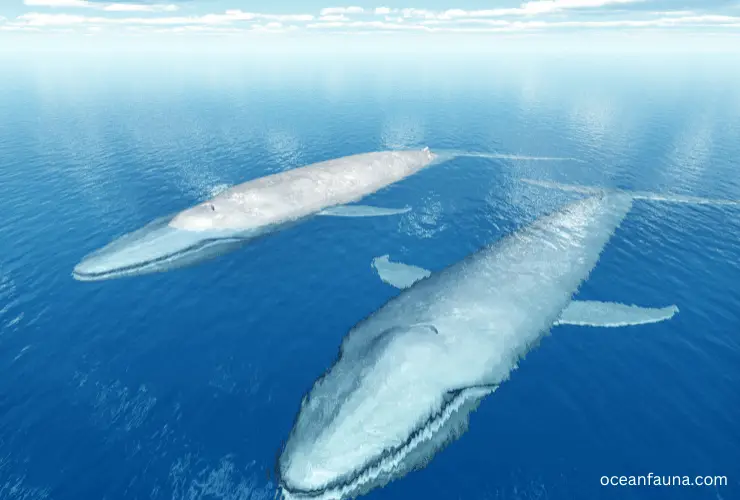
Blue whales are mostly solitary creatures or live in small groups, known as pods, usually consisting of two to three individuals. However, they are sometimes seen in larger congregations in areas with plenty of food. Mating pairs are temporary, and there is little evidence of long-term bonds between individuals.
Communication among blue whales is primarily acoustic, characterized by various low-frequency sounds, including grunts, hums, clicks, moans, and songs. Their vocalizations can travel vast distances in the ocean and are presumed to be used for communication between individuals and possibly navigation.
Mother-calf bonds are strong, with calves staying with their mothers for about a year, as documented by Subhrajit Chakraborty.
Megalodon
Megalodons were likely solitary hunters. Researchers believe that, due to its size and energy requirements, the megalodon likely had large territories it roamed alone, much like the modern great white shark.
Fossil evidence from certain sites, such as the Gatun Formation in Panama, suggests that megalodons might have used specific areas as “nurseries” for their young, as documented in an article published in PLoS ONE.
This behavior is seen in some modern sharks, where they give birth in areas with fewer predators, ensuring a higher survival rate for the juveniles.
| Social Behavior | Blue Whale | Megalodon |
| Grouping | Solitary or small pods | Likely solitary |
| Communication | Acoustic vocalizations | Presumed body language |
| Parental Care | Mothers care for calves for about a year | Likely none after birth, nursery areas for juveniles |
6. Reproduction and Lifecycle
Blue whales and megalodons also exhibit different reproductive and life cycles.
Blue whale
Blue whales are sexually mature between 5-15 years of age. Breeding occurs primarily in the winter to early spring when they are near the surface and in warm waters.
After a gestation period of about 11 months, females give birth to a single calf. Newborn calves are nourished with milk from their mothers and are weaned at around 6-7 months of age. Females reproduce only once every two to three years.
Blue whales can live for at least 70 to 90 years, with the oldest recorded individual estimated to be 110 years old. ~National Geographic
Megalodon
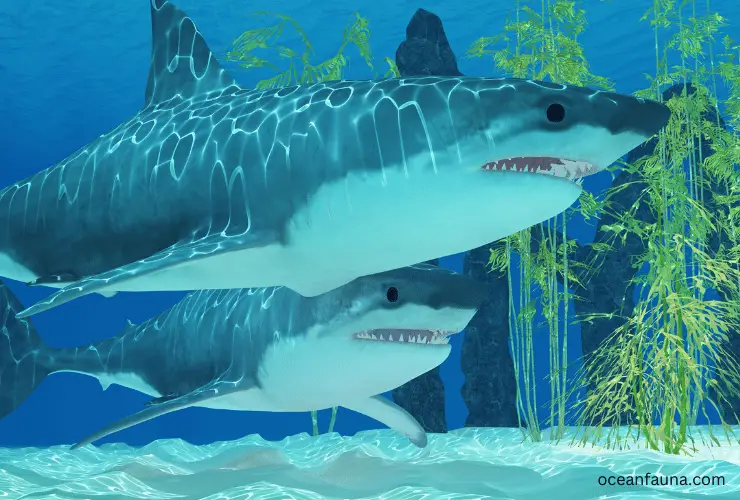
As is common in many shark species, Megalodons likely gave live birth to pups in designated nursery areas with plentiful food and fewer predators.
Megalodon young were probably independent from birth and grew rapidly, eventually leaving the nursery to live in the open ocean.
Evidence suggests that megalodon experienced delayed sexual maturity at around 25 years, as described in an article published in Biology Letters. Female megalodons give birth to live young after a gestation period of 12 months.
The longevity of the megalodon is expected to be 88-100 years, as documented in the journal Historical Biology.
| Reproduction and Lifecycle | Blue Whale | Megalodon |
| Age at Maturity | 5-10 years | 25 years |
| Breeding Season | Winter to early spring | Unknown |
| Gestation Period | ~11 months | ~12 months |
| Offspring per Birth | One | Likely multiple |
| Weaning | 6-7 months | Likely independent from birth |
| Reproduction Frequency | Every 2-3 years | Unknown |
| Lifespan | 70-90 years, up to 110 | 88-100 years |
7. Natural Predators
Given their immense size, both the blue whale and the megalodon had few natural predators to fear. Still, they faced some challenges in their respective ecosystems.
Blue whale
Being giant creatures, adult blue whales have virtually no natural predators. Even the most significant modern predatory shark, the great white shark, is unlikely to threaten an adult blue whale.
However, younger, smaller, or injured blue whales can sometimes fall prey to packs of killer whales (orcas). Orcas have been observed attacking blue whales, focusing on isolated, weak, or young individuals, as documented in the IWC Journal of Cetacean Research and Management.
Megalodon
As a top-level predator, the megalodon likely had no natural predators as an adult. Its enormous size would have made it the ruler of its marine ecosystem.
However, juvenile megalodons might have been vulnerable to other large predatory marine animals, possibly even other megalodons.
Also, although not a direct predation threat, competition from emerging predatory whales such as orcas, great hammerhead sharks, and sperm whales might have impacted megalodon populations, contributing to their extinction. ~Source
| Natural Predators | Blue Whale | Megalodon |
| Adult Predators | Occasional orca attacks | Likely none |
| Juvenile Predators | Orcas | Possible large marine predators (including other megalodons) |
8. Defense Mechanism
Their sheer size is their primary defense mechanism for large creatures, such as the blue whale and the megalodon. However, these two species have evolved different additional defense mechanisms in response to their environmental pressures.
Blue whale
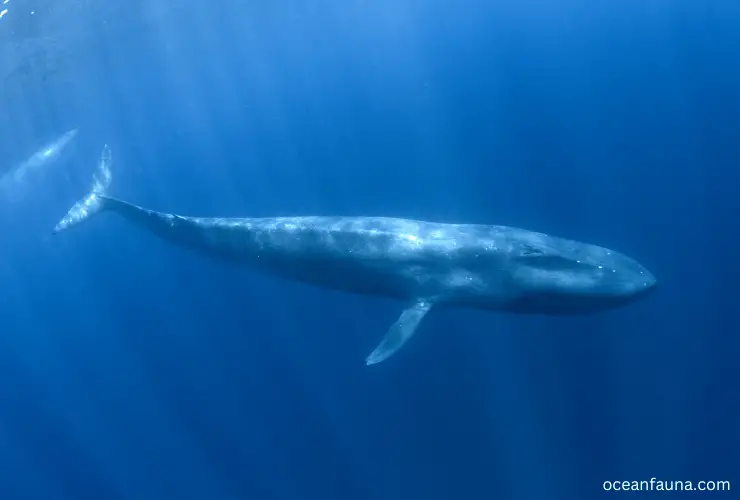
The blue whale relies heavily on its massive size as a preliminary defense against potential predators. Furthermore, they can reach speeds up to 20 mph when threatened, allowing them to outrun most potential threats.
Despite their peaceful nature, blue whales can also use their powerful tail flukes defensively, capable of delivering a potent blow. However, such aggressive defense is rarely observed as most potential predators are deterred by their size alone.
Megalodon
As the apex predator of its time, the megalodon’s primary defense was its sheer size and formidable offensive capabilities. With a length reaching up to 60 feet and equipped with rows of giant, razor-sharp teeth, few if any, marine creatures would dare to threaten a mature megalodon.
Megalodon’s speed (up to 30 mph) and agility, combined with their powerful bite, allowed them to hunt efficiently and deter potential threats. Their thick, robust bodies were built for power and defense against any possible attack.
| Defense Mechanism | Blue Whale | Megalodon |
| Primary Defense | Size, Speed | Size, Powerful bite |
| Physical Defense | Powerful tail fluke | Massive, razor-sharp teeth; Robust body structure |
| Speed | Up to 20 mph | Up to 30 mph |
9. Interaction With Humans
The nature of interactions between humans and these marine giants are quite different due to the latter’s extinction millions of years before the rise of human civilization.
Blue whale
Like many marine animals, blue whales have a long history of interactions with humans, not all of which have benefited these gentle giants.
During the 20th century, humans hunted blue whales extensively for their oil, meat, and baleen, pushing them to the brink of extinction. Commercial whaling was eventually banned in the mid-20th century, allowing the global population of blue whales to slowly recover.
In recent years, interactions between humans and blue whales have been primarily driven by scientific research and eco-tourism.
Whale-watching tours allow people to observe blue whales in their natural habitat, raising awareness about their conservation.
Megalodon
Since the megalodon went extinct about 3.6 million years ago, it never interacted with humans. However, the discovery of megalodon teeth and other fossils has significantly impacted paleontology and our understanding of prehistoric marine life.
The fossils of megalodons have fascinated scientists and the public alike, contributing to numerous research works and spawning a popular cultural interest reflected in movies, books, and documentaries. Through them, we’ve glimpsed the vibrant and mysterious world of prehistoric oceans.
| Human Interaction | Blue Whale | Megalodon |
| Direct Interaction | Extensive: hunting (historically), scientific research, eco-tourism | None (species extinct) |
| Human Interest | Scientific study, conservation efforts, tourism | Paleontological study, popular culture |
10. Threats and Conservation Status
While one species, the blue whale, is currently facing various threats to its survival, the other, the megalodon, went extinct millions of years ago.
Blue whale
Despite international protective measures, the population still faces some threats, as reported by the Journal of Marine Biology. The most significant of these include:
- Ship Strikes,
- Fishing Gear Entanglements,
- Ocean Noise from human activities,
- Climate Change.
The IUCN has listed the blue whale as “Endangered” on its Red List.
Megalodon
The megalodon went extinct millions of years ago. Scientists suggest that climate change, along with a decline in food availability due to competition from emerging marine predators, might have led to its extinction.
| Aspect | Blue Whale | Megalodon |
| Current Threats | Ship strikes, entanglement in fishing gear, ocean noise, climate change | N/A (species extinct) |
| IUCN Status | Endangered | Extinct |
Blue Whale vs Megalodon: Who Would Win the Battle?
Blue whales are much larger than megalodons. Yet, size isn’t the sole determinant of victory.
Megalodons were apex predators with teeth that could reach over 6 inches long, arranged in a mouth nearly 10 feet wide.
Their jaw, laden with multiple rows of these teeth, could exert an impressive bite force estimated to be around 40,000 pounds per square inch – one of the strongest bites ever.
In contrast, blue whales possess no true teeth. Instead, they use baleen plates to sieve tiny krill and fish.
Given their predatory nature, megalodons were likely far more agile and aggressive in hunting. They had evolved over millions of years, perfecting their predatory skills to be at the top of their food chain.
So, the megalodon would undeniably have the upper hand if they fought. Its sheer physical strength and size, combined with its formidable dental weaponry, would make it an unmatched opponent for the blue whale.
Wrapping Up
So, are the blue whale and megalodon the same? Far from it! These two marine giants represent vastly different chapters of Earth’s history. The blue whale, a peaceful and enormous filter-feeder, graces our current oceans with its presence, even as it faces various threats.
On the other hand, the megalodon was a formidable predator of prehistoric times, long extinct but still captivating our imaginations with its sheer size and power.
We truly hope you enjoyed diving into this knowledge journey with us! Come back anytime for more informative creature comparisons. Catch you next time!

